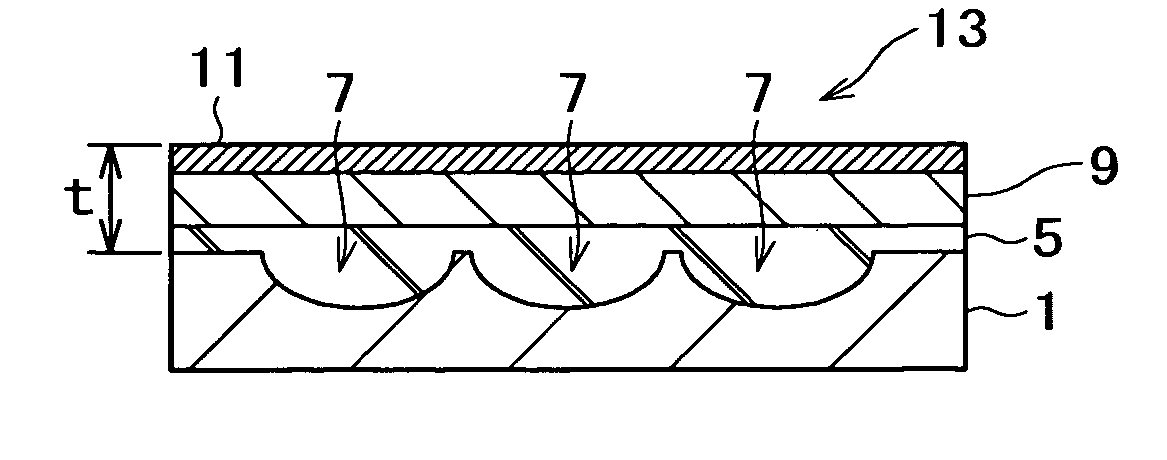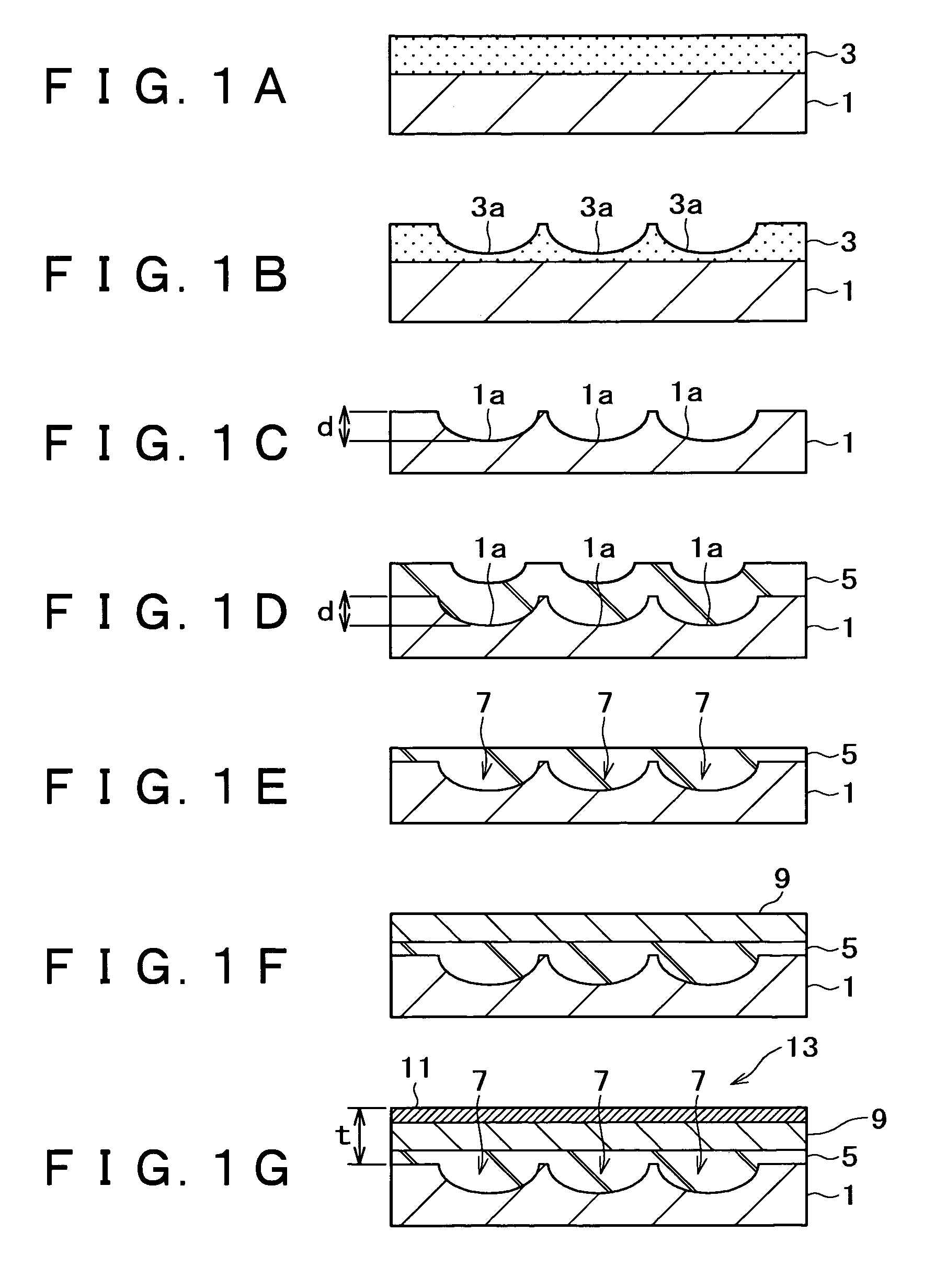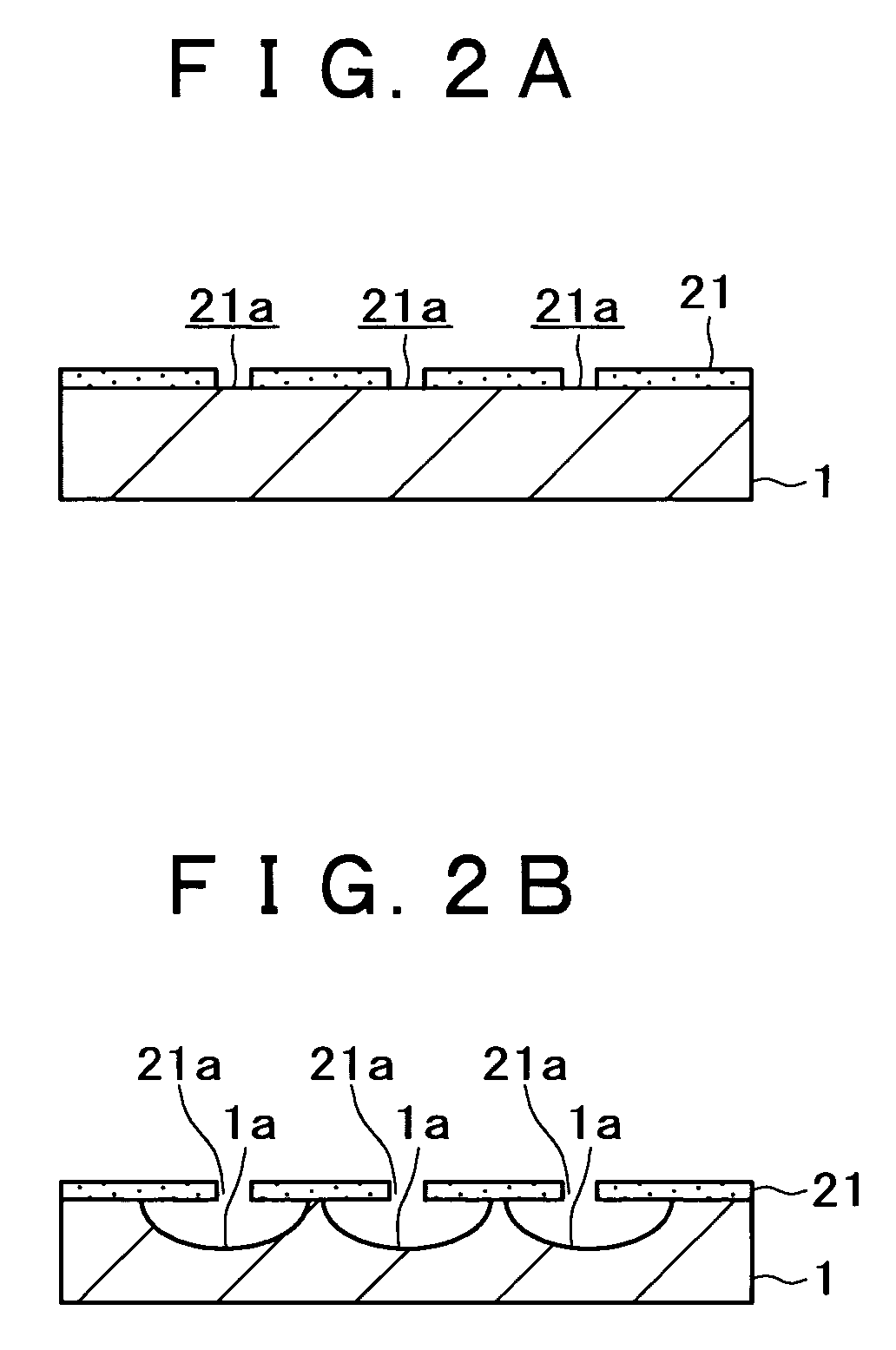Method for manufacturing a microlens substrate and method for manufacturing a liquid crystal panel
a microlens substrate and liquid crystal display technology, which is applied in the field of manufacturing a microlens substrate and a manufacturing method of a liquid crystal display, can solve the problems of not being able to use a UV-curable resin, unable to meet the requirements of liquid crystal display requirements, and other than the visible light transmittance (1), so as to improve heat resistance, light fastness, and good chemical resistance
- Summary
- Abstract
- Description
- Claims
- Application Information
AI Technical Summary
Benefits of technology
Problems solved by technology
Method used
Image
Examples
embodiment 1
[0034]FIGS. 1A to 1B are, respectively, a sectional view illustrating a first example of a method of manufacturing a microlens substrate according to the invention. The first embodiment is illustrated with reference to these figures.
[0035]Initially, as shown in FIG. 1A, a resist film 3 is formed on a transparent substrate 1, which has, for example, a diameter of 6 inches and is made of fused silica (or Neoceram). In this case, the resist film 3 is formed in a thickness of 10 μm according to a spin coating technique.
[0036]Next, as shown in FIG. 1B, the resist film 3 is subjected to lithographic treatment at the surface side to form an array of lens-shaped concave curves which are a basic pattern of microlenses. In this embodiment, concave curves 3a are formed in the respective pixel regions of about 14 μm×14 μm created by partitioning a display region at the center of the surface side of the transparent substrate 1.
[0037]In this lithographic treatment, multiple exposure is carried ou...
embodiment 2
[0055]A second example of a method for manufacturing a microlens substrate according to the invention is illustrated with reference to FIGS. 2A and 2B which are, respectively, a sectional process view.
[0056]Initially, as shown in FIG. 2A, a resist pattern 21 is formed on a transparent substrate 1 similar to that used in the first embodiment by a lithographic technique. This resist pattern 21 has a hole 21a at the center of a lens-shaped concave curve to be formed, which is a basic pattern of a microlens.
[0057]Next, as shown inFIG. 2B, the transparent substrate 1 is isotropically etched through a mask of the resist pattern 21. This allows the isotropic etching to proceed around the hole 21a of the resist pattern 21, and concave curves 1a are formed in array within the respective pixel regions of a size of about 14 μm×14 μm formed by partitioning a display region at the center of the surface side of the transparent substrate 1. The respective concave curves 1a formed in this way are s...
embodiment 3
[0061]Next, a method for manufacturing a microlens substrate according to a third embodiment of the invention is illustrated with reference to FIGS. 3A to 3D which are, respectively, a sectional process view. It will be noted that these sectional process views corresponding to enlarged views of an essential part of FIGS. 1A to 1G and 2A to 2B.
[0062]Initially, the steps illustrated with reference to FIGS. 1A to 1F in the first embodiment are, for example, carried out to form a microlens 7 wherein a concave curve 1a of a transparent substrate 1 is buried with an inorganic material film 5 as shown in FIG. 3A, and further to form a cover film 9. It will be noted that the procedure up to and including this step may be carried out by application of the procedure of the second embodiment.
[0063]Next, as shown in FIG. 3B, a light-shielding film pattern 31 is formed on the cover film 9. This light-shielding film pattern 31 is disposed at a position surrounding individual microlenses 7 or alon...
PUM
| Property | Measurement | Unit |
|---|---|---|
| wavelength region | aaaaa | aaaaa |
| diameter | aaaaa | aaaaa |
| thickness | aaaaa | aaaaa |
Abstract
Description
Claims
Application Information
 Login to View More
Login to View More - R&D
- Intellectual Property
- Life Sciences
- Materials
- Tech Scout
- Unparalleled Data Quality
- Higher Quality Content
- 60% Fewer Hallucinations
Browse by: Latest US Patents, China's latest patents, Technical Efficacy Thesaurus, Application Domain, Technology Topic, Popular Technical Reports.
© 2025 PatSnap. All rights reserved.Legal|Privacy policy|Modern Slavery Act Transparency Statement|Sitemap|About US| Contact US: help@patsnap.com



